
 “AMD in many cases delivers greater performance than the similarly priced Intel CPUs, but not nearly a large enough performance gap to make up for the difference in die size. Again, great for consumers, but potentially painful for AMD in the long run. As yields improve AMD should be able to make more of these cores members of the 900 family, but without a separate, smaller die there will still be economic inefficiencies at the lower end.”
“AMD in many cases delivers greater performance than the similarly priced Intel CPUs, but not nearly a large enough performance gap to make up for the difference in die size. Again, great for consumers, but potentially painful for AMD in the long run. As yields improve AMD should be able to make more of these cores members of the 900 family, but without a separate, smaller die there will still be economic inefficiencies at the lower end.”“AMD’s Phenom II is very competitive, but the strategy does not have much long term staying power. AMD needs to introduce smaller die versions of its CPUs soon.”
Ask and you shall receive, right?
Intel did a bang up job tarnishing the Pentium name with its clock speed rampage during the Pentium 4 days, but the Athlon brand still holds a special place in our hearts.
This is the Athlon II, and it’s exactly what I’ve been asking for:
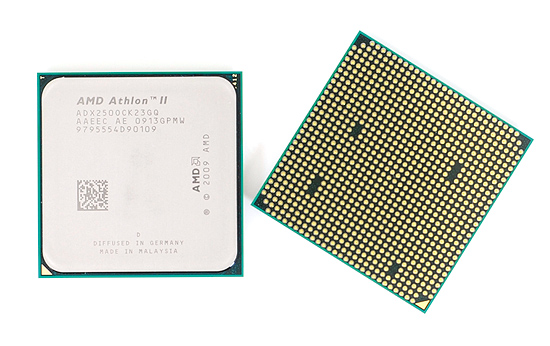
The Athlon II X2, to be specific, is a 45nm monolithic dual-core processor. While the most recent Athlon X2s are derivatives of the original Phenom architecture, the Athlon II is based on the new and improved Phenom II architecture.
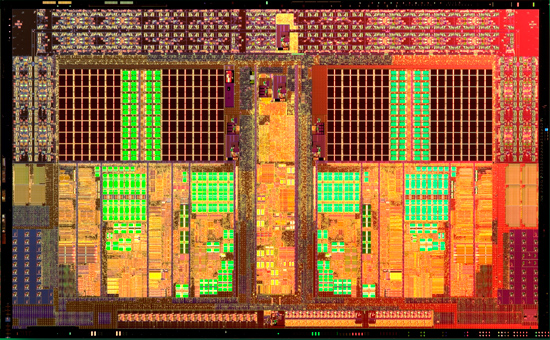
The name lives on
Take two Phenom II cores, increase their L2 caches to 1MB, leave out the L3 and you’ve got an Athlon II. The entire die measures only 117.5 mm^2 and is made up of a meager 234 million transistors. The table below compares the Athlon II’s die size to other competing parts:
| Processor | Cores | Manufacturing Process | L1 Cache | L2 Cache | L3 Cache | Die Size | Transistor Count |
| AMD Phenom II X2 | 2 | 45nm | 128KB per core | 1MB | 6MB | 258 mm2 | 758M |
| AMD Athlon II X2 | 2 | 45nm | 128KB per core | 1MB per core | 0MB | 117 mm2 | 234M |
| AMD Athlon X2 | 2 | 65nm | 128KB per core | 512KB per core | 2MB | 285 mm2 | 450M |
| AMD Athlon 64 X2 | 2 | 65nm | 128KB per core | 512KB per core | 0MB | 126 mm2 | 154M |
| Intel Pentium for Desktop | 2 | 45nm | 64KB per core | 2MB | 0MB | 82 mm2 | 228M |
The new Athlon II is actually AMD’s smallest dual core processor ever, even smaller than the original Athlon 64 X2. It’s also AMD’s first 45nm dual-core processor. It’s also AMD’s first Socket-AM3 processor to carry the Athlon brand (ok, I’ll stop). As an AM3 chip it will work in both AM3 and AM2+ motherboards, just like the Phenom II.
The Athlon II is only launching with one model today the 3.0GHz Athlon II X2 250. Priced at $87, it’s likely that we won’t see more Athlon II X2s until AMD is ready to further switch its lineup over to 45nm in order to keep up with demand.
The Phenom II X2 550 BE
We actually get two new dual-core chips today, the second is the new Phenom II X2 550 Black Edition. Like all of the other chips in the Phenom II lineup, the X2 550 is simply a die-harvested Phenom II X4 part. In other words, what we have is a quad-core Phenom II with two of its cores disabled. Given that it’s still fairly early in GlobalFoundries’ 45nm manufacturing process, it makes sense to see so many harvested parts. I would expect these Phenom II X2 and perhaps even the X3 derivatives to either disappear or shift out of the limelight as AMD’s yields improve.
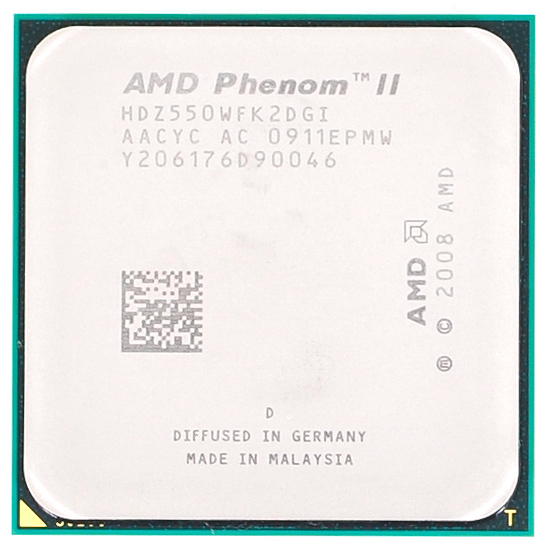
Because it’s based on the quad-core Phenom II processor, the X2 550 BE has a full 6MB L3 cache that the two cores can share. The L2 caches are still stuck at 512KB but with a large 6MB L3, there’s very little to complain about. The unlocked Black Edition part runs at 3.1GHz and retails for $102.
Availability and New Energy Efficient Phenom IIs
AMD is expecting availability for both of these parts in the next week or so.
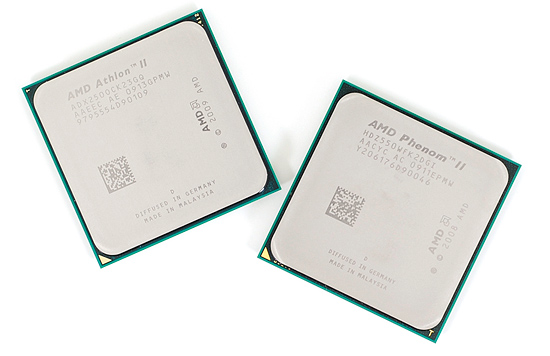
The table below shows AMD’s new lineup with these two chips. Note that I’ve also included data on the Phenom II X4 905e and the Phenom II X3 705e. These two CPUs run at 2.5GHz and have a 65W TDP, down from 125W and 95W for all previous AM3 parts.
| Processor | Cores | Clock Speed | un-core Clock | L2 Cache | L3 Cache | TDP | Price |
| AMD Phenom II X4 955 BE | 4 | 3.2GHz | 2.0GHz | 2MB | 6MB | 125W | $245 |
| AMD Phenom II X4 945 | 4 | 3.0GHz | 2.0GHz | 2MB | 6MB | 125W | $225 |
| AMD Phenom II X4 940 BE | 4 | 3.0GHz | 1.8GHz | 2MB | 6MB | 125W | $225 |
| AMD Phenom II X4 920 | 4 | 2.8GHz | 1.8GHz | 2MB | 6MB | 125W | $195 |
| AMD Phenom II X4 910 | 4 | 2.6GHz | 2.0GHz | 2MB | 6MB | 95W | $??? |
| AMD Phenom II X4 905e | 4 | 2.5GHz | 2.0GHz | 2MB | 6MB | 65W | $195 |
| AMD Phenom II X4 810 | 4 | 2.6GHz | 2.0GHz | 2MB | 4MB | 95W | $175 |
| AMD Phenom 9950 | 4 | 2.6GHz | 2.0GHz | 2MB | 2MB | 140W | $173 |
| AMD Phenom II X4 805 | 4 | 2.5GHz | 2.0GHz | 2MB | 4MB | 95W | $??? |
| AMD Phenom II X3 720 BE | 3 | 2.8GHz | 2.0GHz | 1.5MB | 6MB | 95W | $145 |
| AMD Phenom II X3 710 | 3 | 2.6GHz | 2.0GHz | 1.5MB | 6MB | 95W | $125 |
| AMD Phenom II X3 705e | 3 | 2.5GHz | 2.0GHz | 1.5MB | 6MB | 65W | $125 |
| AMD Phenom II X2 550 BE | 2 | 3.1GHz | 2.0GHz | 1MB | 6MB | 80W | $102 |
| AMD Athlon II X2 250 | 2 | 3.0GHz | 2.0GHz | 2MB | 0MB | 65W | $87 |
| AMD Athlon X2 7850 | 2 | 2.8GHz | 1.8GHz | 1MB | 2MB | 95W | $69 |
And just for kicks here's a specs table with both AMD and Intel CPUs in it:
| Processor | Cores | Manufacturing Process | L1 Cache | L2 Cache | L3 Cache | Die Size | Transistor Count |
| AMD Phenom II X4 | 4 | 45nm | 128KB per core | 2MB | 6MB | 258 mm2 | 758M |
| AMD Phenom II X3 | 3 | 45nm | 128KB per core | 2MB | 6MB | 258 mm2 | 758M |
| AMD Phenom II X2 | 2 | 45nm | 128KB per core | 2MB | 6MB | 258 mm2 | 758M |
| AMD Athlon II X2 | 2 | 45nm | 128KB per core | 1MB per core | 0MB | 117 mm2 | 234M |
| AMD Athlon X2 | 2 | 65nm | 128KB per core | 512KB per core | 2MB | 285 mm2 | 450M |
| AMD Athlon 64 X2 | 2 | 65nm | 128KB per core | 512KB per core | 0MB | 126 mm2 | 154M |
| Intel Core i7 | 4 | 45nm | 64KB per core | 256KB per core | 8MB | 263 mm2 | 731M |
| Intel Core 2 Quad | 4 | 45nm | 64KB per core | 12MB | 0MB | 214 mm2 | 820M |
| Intel Core 2 Quad | 4 | 45nm | 64KB per core | 4MB | 0MB | 164 mm2 | 456M |
| Intel Core 2 Duo | 2 | 45nm | 64KB per core | 6MB | 0MB | 107 mm2 | 410M |
| Intel Core 2 Duo | 2 | 45nm | 64KB per core | 3MB | 0MB | 82 mm2 | 228M |
| Intel Pentium | 2 | 45nm | 64KB per core | 2MB | 0MB | 82 mm2 | 228M |
Athlon II X2: Hardware C1E and Return of the CnQ Bug
I noticed something strange in my initial testing of the Athlon II X2, take a look at these SYSMark results:
| Processor | SYSMark 2007 Overall |
| AMD Phenom II X2 550 BE (3.10GHz) | 167 |
| AMD Athlon II X2 250 (3.00GHz) | 134 |
| AMD Athlon X2 7850 (2.80GHz) | 145 |
The Athlon II X2 250 is slower than the Athlon X2 7850 and significantly slower than the Phenom II X2 550. Remembering the Cool’n’Quiet bug from the original Phenom processor I decided to turn CnQ off in the BIOS to see if the scores would go up:
| Processor | SYSMark 2007 Overall - CnQ On | SYSMark 2007 Overall - CnQ Off |
| AMD Athlon II X2 250 (3.00GHz) | 134 | 148 |
Indeed they did.
I contacted AMD and was informed that there’s more than meets the eye with the Athlon II X2. Although the architecture is fundamentally a couple of Phenom II cores with larger L2 caches and no L3, there’s one more change to the die: microcode support for the C1E power state.
When the OS executes a halt instruction on a CPU (during a period of no activity for example) the clock signal is shut off to the CPU for a period of time. This saves power as no transistors are actively switching during this time. Voltage supplied to the processor is left unchanged however. This power state is known as C1.
In the late Pentium 4 era Intel introduced an Enhanced Halt State, called C1E. Instead of just shutting off the clock to the CPU, when a CPU was in C1E its clock speed and voltage would both be reduced to their lowest possible value. The reduction in voltage results in a reduction in leakage current, which in turn saves power.
Apparently prior to the Athlon II X2, AMD enabled support for C1E outside of the processor. Although I tried, I couldn’t get access to anyone at AMD to explain things any further so what I offer is my best guess. I’m guessing that whenever a halt instruction was executed by the OS, AMD used some combination of its existing C1 support and Cool’n’Quiet to both stop the clock to the CPU and reduce voltage.
Regardless of how AMD enabled it, motherboard makers were constantly botching it up in their BIOS which would result in different motherboards having very different power consumption levels especially at idle. It appears that some vendors were properly enabling this software-hack C1E state while others weren’t.
AMD always expressed frustration to me that the motherboard vendors kept screwing things up and I’m guessing they got tired of dealing with it. The new Athlon II X2 has microcode level support for the C1E state; when the OS executes a halt instruction, the CPU now knows to both shut off its clock and drop its voltage. No BIOS trickery necessary.
The problem with this, as you can guess, is that not all current motherboards have proper BIOS support for it. Yep.
But that’s only half of the problem. Simply not supporting the new hardware C1E in the Athlon II X2 won’t cause the issue I saw above, that has to do with Cool’n’Quiet, not C1E. So what’s going on?
Late last week AMD finally got back to me with an answer. The feature that caused the CnQ bug in the original Phenom processor was the processor’s ability to run each core at a different clock speed. A nasty combination of Windows’ scheduler and the Phenom’s power management could result in cores, under load, running at 50% of their frequency. AMD fixed the problem by removing the feature; in the Phenom II all cores attempt to run at the same frequency.
When AMD put out its master BIOS code for all 7xx series reference motherboards, the Athlon II did not exist. The fix that was applied to the Phenom II would not be applied to any other Phenom II based derivatives, they would simply get treated as original Phenom processors with varying clock speeds between cores.
And that’s what’s going on. The Athlon II isn’t told to run both of its cores at the same frequency and thus you can have situations where performance is much lower than it should be.
AMD is aware of the issue and are currently working with motherboard vendors to properly enable BIOS support for the Athlon II. Until then, the best way to run and use the Athlon II is with CnQ disabled. Unlike the original Phenom, this bug should get fixed in the near future.
Intel’s Response: The Pentium E6300
AMD has two new dual-core chips priced at $87 and $102, both run at or around 3.0GHz and have a fair amount of cache. The Athlon II X2 250 has a 1MB L2 per core (2MB total) while the Phenom II X2 550 BE has a large 6MB L3 to share between its two cores. These are both very healthy sounding processors, borderline scary if you’re Intel.
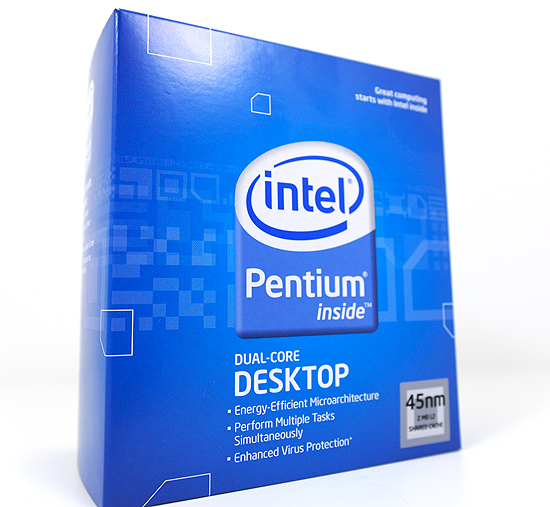
The Pentium E6300
In the blue corner we have the new Pentium E6300. It’s a 45nm monolithic dual-core part, just like the Athlon II X2. It has a 2MB L2 cache also like the Athlon II X2, albeit shared between the two cores which is potentially an upside. Unlike previous Pentium for Desktop (that’s the official name) processors, the E6300 uses a 1066MHz FSB and it supports Intel’s VT. The problem? The E6300 only runs at 2.80GHz; AMD has a clock speed advantage.

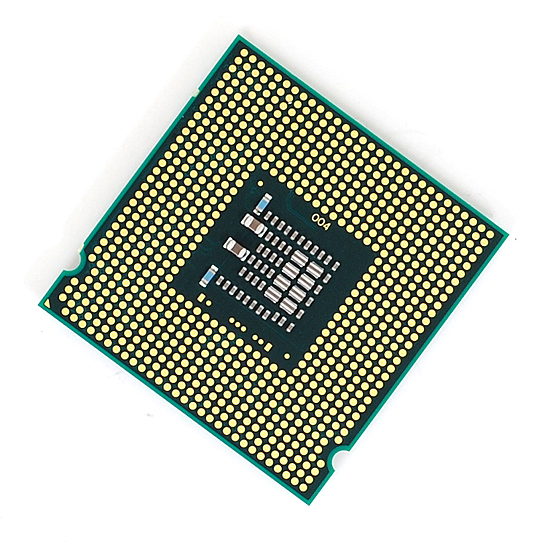
In our first Phenom II review I talked about how AMD needs a clock speed advantage to compete. Compared to a large-cache Core 2, that’s very true, but the E6300 doesn’t have a healthy 6MB L2 for two cores. It’s only got 2MB. All of the sudden things aren’t looking so rosy for Intel.
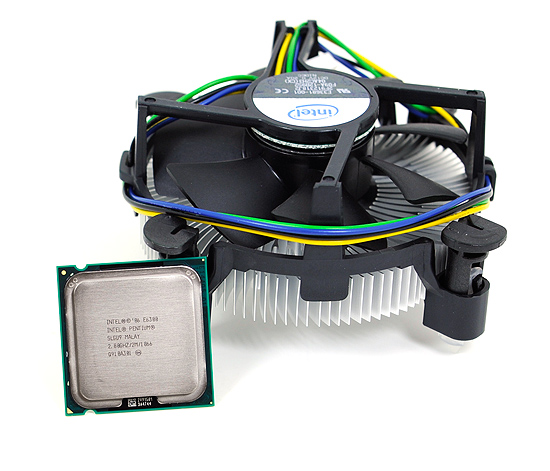
An inherent advantage of Intel’s Core architecture is its 4-issue front end (which in some cases can behave like a 5-issue front end). The problem is feeding such a beast requires very fast memory access. The Pentium E6300 is still based on the same architecture as the Core 2 Duo, meaning it has no on-die memory controller. Rob it of a decent sized cache and its performance suffers. A quick look at Bench shows us that even an extra megabyte of cache helps tremendously:
| Processor | SYSMark 2007 Overall |
| Intel Core 2 Duo E7500 (2.93GHz/3MB L2) | 173 |
| Intel Pentium E6300 (2.80GHz/2MB L2) | 158 |
Note that when Conroe first launched some parts (the Core 2 Duo E6300 funny enough) only had a 2MB L2. The problem is that was nearly three years ago; applications have grown in size and so have their demands from processors. What was acceptable back then is now not. I’d like to see Intel move its 3MB L2 caches down to these sub-$100 price points. But I’ll let the benchmarks decide whether or not it’s necessary.
| Processor | Clock Speed | L2 Cache | TDP | Price |
| Intel Core 2 Quad Q9650 | 3.00GHz | 12MB | 95W | $316 |
| Intel Core 2 Quad Q9550 | 2.83GHz | 12MB | 95W | $266 |
| Intel Core 2 Quad Q9400 | 2.66GHz | 6MB | 95W | $213 |
| Intel Core 2 Quad Q9300 | 2.50GHz | 6MB | 95W | $213 |
| Intel Core 2 Quad Q8400 | 2.66GHz | 4MB | 95W | $183 |
| Intel Core 2 Quad Q8300 | 2.50GHz | 4MB | 95W | $183 |
| Intel Core 2 Quad Q8200 | 2.33GHz | 4MB | 95W | $163 |
| Intel Core 2 Duo E8600 | 3.33GHz | 6MB | 65W | $266 |
| Intel Core 2 Duo E8500 | 3.16GHz | 6MB | 65W | $183 |
| Intel Core 2 Duo E8400 | 3.00GHz | 6MB | 65W | $163 |
| Intel Core 2 Duo E7500 | 2.93GHz | 3MB | 65W | $133 |
| Intel Core 2 Duo E7400 | 2.80GHz | 3MB | 65W | $113 |
| Intel Core 2 Duo E7300 | 2.66GHz | 3MB | 65W | $113 |
| Intel Pentium E6300 | 2.80GHz | 2MB | 65W | $84 |
| Intel Pentium E5400 | 2.70GHz | 2MB | 65W | $84 |
| Intel Pentium E5300 | 2.60GHz | 2MB | 65W | $74 |
| Intel Pentium E5200 | 2.50GHz | 2MB | 65W | $64 |
| Intel Pentium E2220 | 2.40GHz | 1MB | 65W | $64 |
| Intel Pentium E2200 | 2.20GHz | 1MB | 65W | $64 |
| Intel Celeron E1500 | 2.20GHz | 512KB | 65W | $53 |
| Intel Celeron E1400 | 2.00GHz | 512KB | 65W | $43 |
| Intel Celeron 450 | 2.20GHz | 512KB | 35W | $53 |
| Intel Celeron 440 | 2.00GHz | 512KB | 35W | $44 |
| Intel Celeron 430 | 1.80GHz | 512KB | 35W | $34 |
A Blast from the Past: The Pentium 4 660 and the Pentium Extreme Edition 955
Two weeks ago I asked everyone what older CPUs they’d like to see included in one of our quietly introduced features on AnandTech: Bench. I got requests for everything from original Pentium processors to VIA’s Nano. While I’m working on adding additional data to the tool I just finished testing two older CPUs over the weekend that I thought would be useful in this review: the Pentium 4 660 and the Pentium Extreme Edition 955.
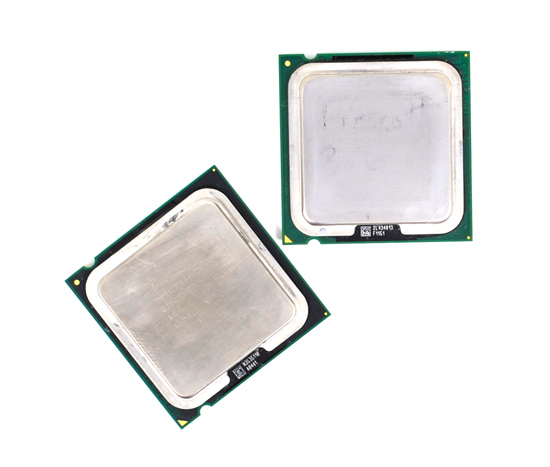
Pentium Extreme Edition 955 (left) and Pentium 4 660 (right)
Both of these CPUs are from 2005. The Pentium 4 660 was a single-core processor based on Intel’s infamous Prescott core. The processor had a 2MB L2 cache and Hyper Threading support; it ran at 3.6GHz, a higher clock speed than any current AMD or Intel processor.
The Pentium EE 955 is based on two separate Intel 65nm Presler cores on one package (ah, remember the early days of dual-core?). The 955 ran at 3.46GHz but had HT enabled, allowing it to execute 4 threads at the same time.
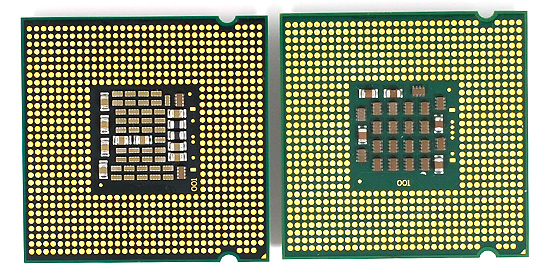
Pentium Extreme Edition 955 (left) and Pentium 4 660 (right)
When the Pentium 660 debuted it cost $605, while the Pentium EE 955 would set you back $999 in 2005. These were some of the fastest Pentium 4s ever released and you’ll see them compared to a couple of ~$90 CPUs here today.
The Test
| Motherboard: | Intel DX58SO (Intel X58) Intel DX48BT2 (Intel X48) MSI DKA790GX Platinum (AMD 790GX) Gigabyte GA-MA790GP-DS4H (AMD 790GX) Gigabyte GA-MA790FX-UD5P (AMD 790FX) |
| Chipset: | Intel X48 Intel X58 AMD 790GX AMD 790FX |
| Chipset Drivers: | Intel 9.1.1.1012 (Intel) AMD Catalyst 8.12 |
| Hard Disk: | Intel X25-M SSD (80GB) |
| Memory: | G.Skill DDR2-800 2 x 2GB (4-4-4-12) G.Skill DDR2-1066 2 x 2GB (5-5-5-15) Qimonda DDR3-1066 4 x 1GB (7-7-7-20) Corsair DDR3-1333 4 x 1GB (7-7-7-20) |
| Video Card: | eVGA GeForce GTX 280 |
| Video Drivers: | NVIDIA ForceWare 180.43 (Vista64) NVIDIA ForceWare 178.24 (Vista32) |
| Desktop Resolution: | 1920 x 1200 |
| OS: | Windows Vista Ultimate 32-bit (for SYSMark) Windows Vista Ultimate 64-bit |
SYSMark 2007 Performance
Our journey starts with SYSMark 2007, the only all-encompassing performance suite in our review today. The idea here is simple: one benchmark to indicate the overall performance of your machine.
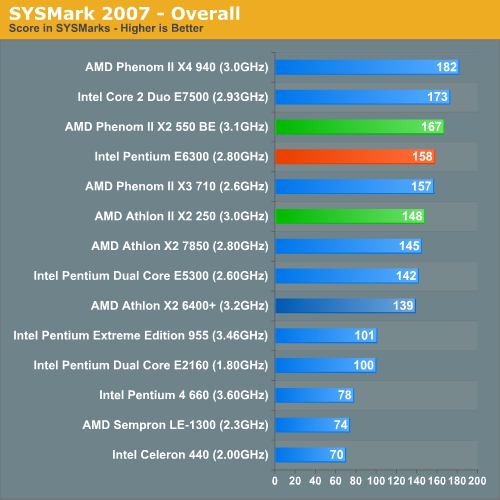
True to its pricing, the Pentium E6300 falls right in between the Phenom II X2 550 and the Athlon II X2 250. Note that the higher clock speed of the Phenom II 550 gives it the edge over the more expensive Phenom II X3 710. The Phenom II 550 is also nipping at the heels of the $133 Core 2 Duo E7500; not bad.
Note that all of the chips are around 50% faster than the Pentium Extreme Edition 955 and over 90% faster than the Pentium 4 660. Chances are, if you own a PC from 2005 then an $80 CPU will give you at least twice the performance.
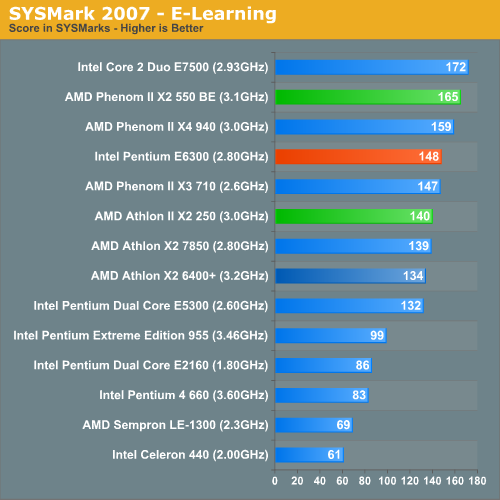

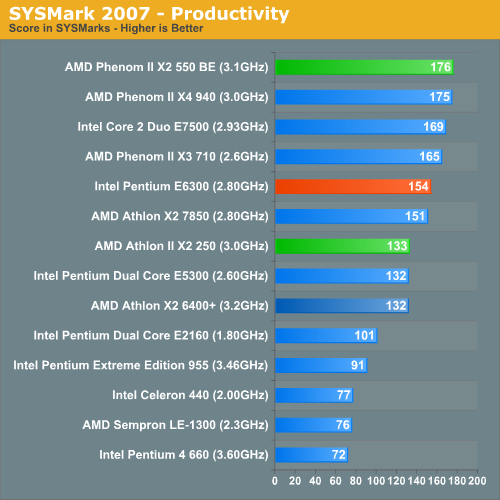
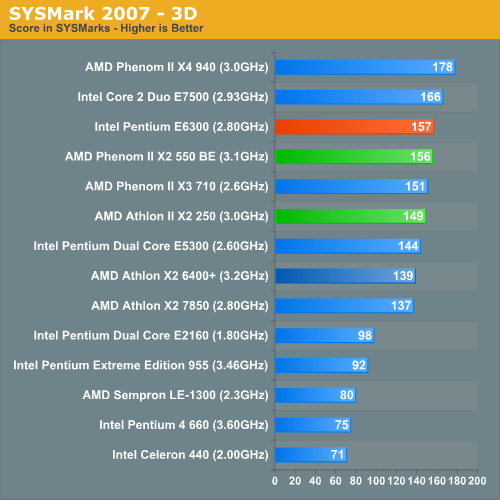
Adobe Photoshop CS4 Performance
To measure performance under Photoshop CS4 we turn to the Retouch Artists’ Speed Test. The test does basic photo editing; there are a couple of color space conversions, many layer creations, color curve adjustment, image and canvas size adjustment, unsharp mask, and finally a gaussian blur performed on the entire image.
The whole process is timed and thanks to the use of Intel's X25-M SSD as our test bed hard drive, performance is far more predictable than back when we used to test on mechanical disks.
Time is reported in seconds and the lower numbers mean better performance. The test is multithreaded and can hit all four cores in a quad-core machine.
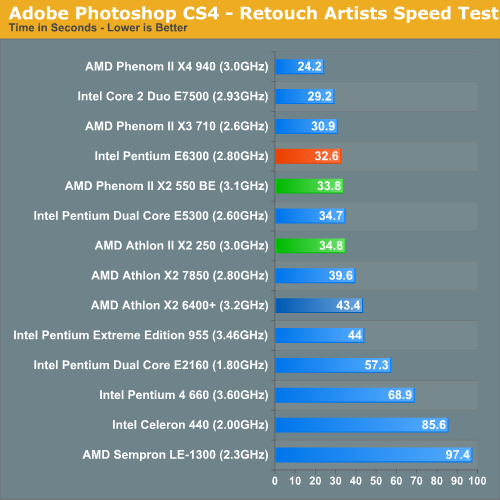
The Pentium E6300 pulls ahead in our CS4 benchmark; it's faster than both the Phenom II 550 and the Athlon II 250. Note the significant increase in performance from the Athlon X2 7850 to the Athlon II X2 250. All of the benefits of the Phenom II architecture are wrapped into the new Athlon II.
DivX 8.5.3 with Xmpeg 5.0.3
Our DivX test is the same DivX / XMpeg 5.03 test we've run for the past few years now, the 1080p source file is encoded using the unconstrained DivX profile, quality/performance is set balanced at 5 and enhanced multithreading is enabled:
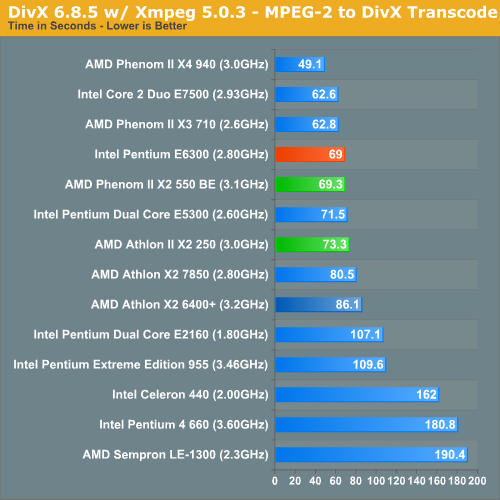
DivX performance is very close between all three contenders. The E6300 and Phenom II 550 are virtually tied while the Athlon II 250 isn't far behind. For faster performance in encoding you need more cores though.
The Pentium EE 955, at one time an encoding monster, is now as fast as a Pentium E2160 in our DivX test.
x264 HD Video Encoding Performance
Graysky's x264 HD test uses the publicly available x264 codec (open source alternative to H.264) to encode a 4Mbps 720p MPEG-2 source. The focus here is on quality rather than speed, thus the benchmark uses a 2-pass encode and reports the average frame rate in each pass.
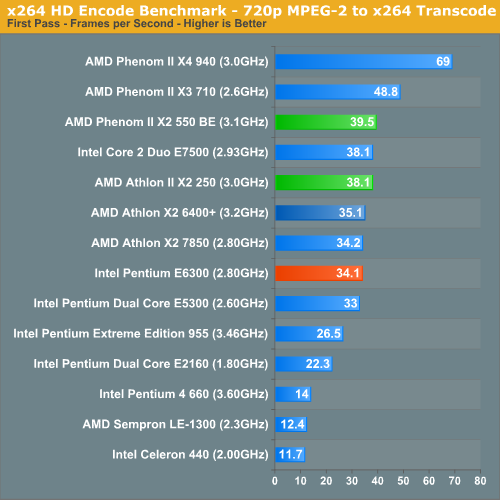
The latest version of the x264 codec fixes the problem exemplified in our first pass results, but these are still interesting to look at. Because of a number of unaligned memory loads all of Intel's pre-Nehalem Core based processors are penalized. The result is both the Athlon II and Phenom II are ahead of the E6300 here.
In the second pass of the test however, things return to "normal". The E6300 is technically in between the two new AMD dual-core chips, but all three basically perform the same. The Phenom II X3 710 adds another 40% to the processor cost and yields an extra ~20% in performance.
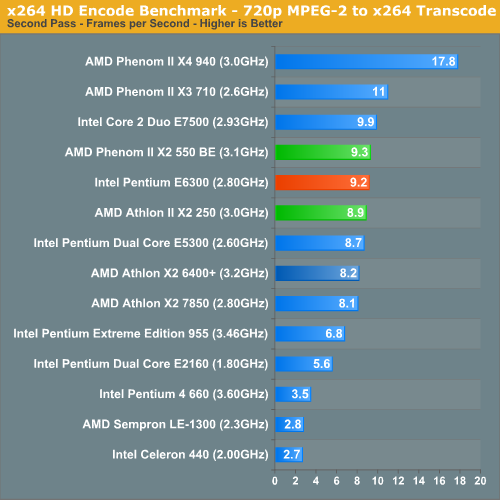
Windows Media Encoder 9 x64 Advanced Profile
In order to be codec agnostic we've got a Windows Media Encoder benchmark looking at the same sort of thing we've been doing in the DivX and x264 tests, but using WME instead.
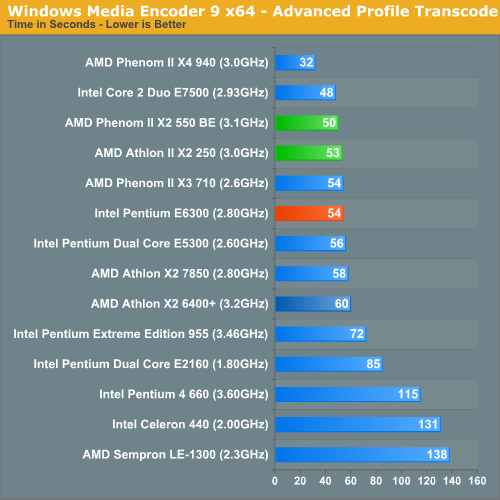
Under WME, both of the AMD chips are a bit faster than the E6300. Note that even the triple-core Phenom II 710 is slower than the Phenom II X2 550; not all applications work well with AMD's odd 3-core configuration.
3dsmax 9 - SPECapc 3dsmax CPU Rendering Test
Today's desktop processors are more than fast enough to do professional level 3D rendering at home. To look at performance under 3dsmax we ran the SPECapc 3dsmax 8 benchmark (only the CPU rendering tests) under 3dsmax 9 SP1. The results reported are the rendering composite scores:
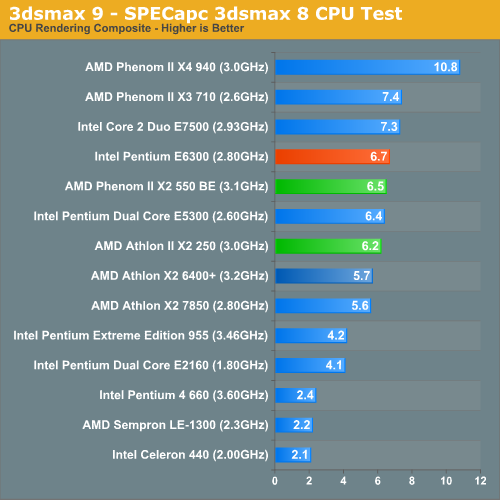
In 3dsmax, the E6300 pulls ahead of the Phenom II X2 550.
Cinebench R10
Created by the Cinema 4D folks we have Cinebench, a popular 3D rendering benchmark that gives us both single and multi-threaded 3D rendering results.
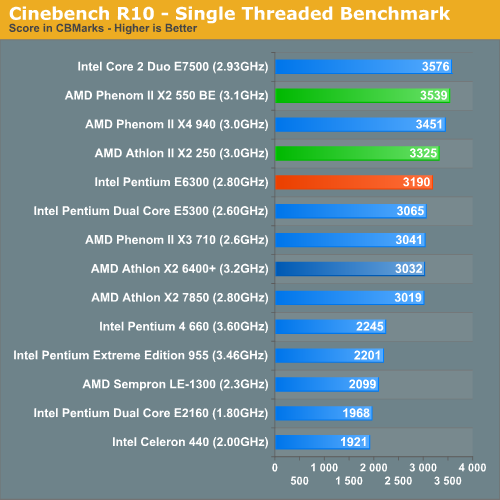
Cinebench has both AMD newcomers outperforming Intel's E6300.
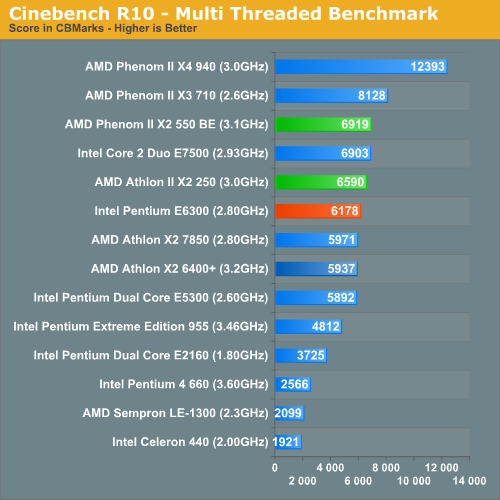
POV-Ray 3.73 beta 23 Ray Tracing Performance
POV-Ray is a popular, open-source raytracing application that also doubles as a great tool to measure CPU floating point performance.
I ran the SMP benchmark in beta 23 of POV-Ray 3.73. The numbers reported are the final score in pixels per second.
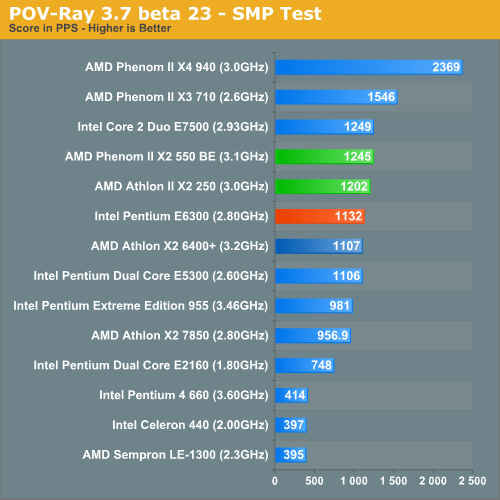
POV-Ray has the E6300 behind its AMD competitors once again. The margins are pretty close, especially when you realize that there's virtually no performance difference between the Athlon II X2 250 and the Phenom II X2 550 BE.
Blender 2.48a
Blender is an open source 3D modeling application. Our benchmark here simply times how long it takes to render a character that comes with the application.
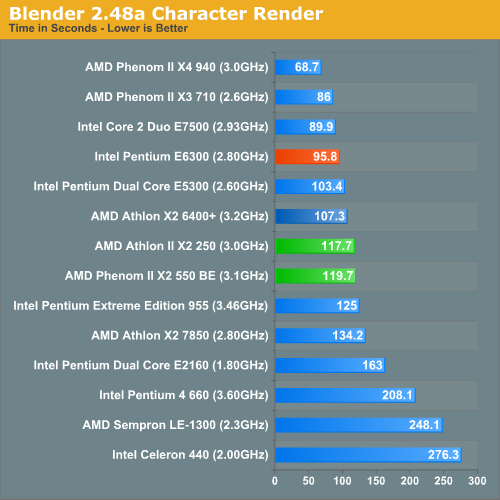
PAR2 Multithreaded Archive Recovery Performance
Par2 is an application used for reconstructing downloaded archives. It can generate parity data from a given archive and later use it to recover the archive
Chuchusoft took the source code of par2cmdline 0.4 and parallelized it using Intel’s Threading Building Blocks 2.1. The result is a version of par2cmdline that can spawn multiple threads to repair par2 archives. For this test we took a 708MB archive, corrupted nearly 60MB of it, and used the multithreaded par2cmdline to recover it. The scores reported are the repair and recover time in seconds.
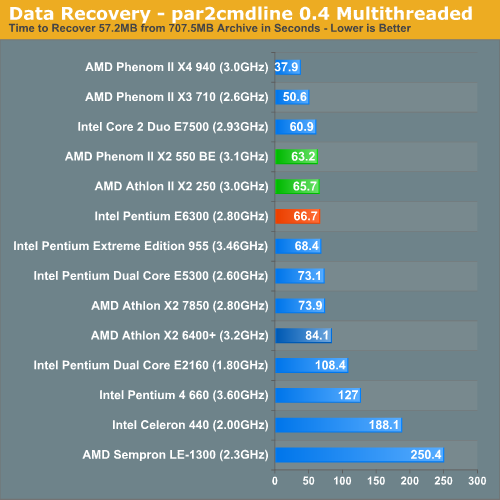
Microsoft Excel 2007
Excel can be a very powerful mathematical tool. In this benchmark we're running a Monte Carlo simulation on a very large spreadsheet of stock pricing data.
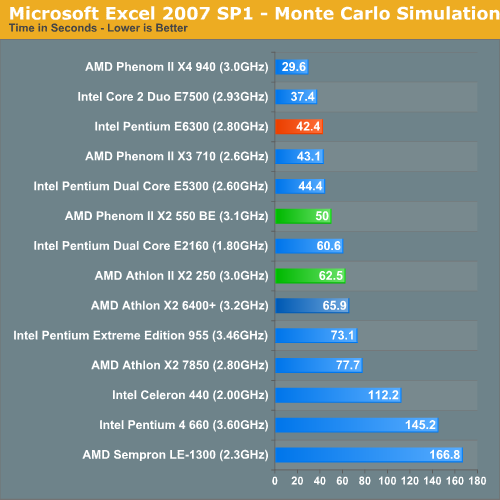
Sony Vegas Pro 8: Blu-ray Disc Creation
Although technically a test simulating the creation of a Blu-ray disc, the majority of the time in our Sony Vegas Pro benchmark is spend encoding the 25Mbps MPEG-2 video stream and not actually creating the Blu-ray disc itself.

Sorenson Squeeze: FLV Creation
Another video related benchmark, we're using Sorenson Squeeze to convert regular videos into Flash videos for use on websites.
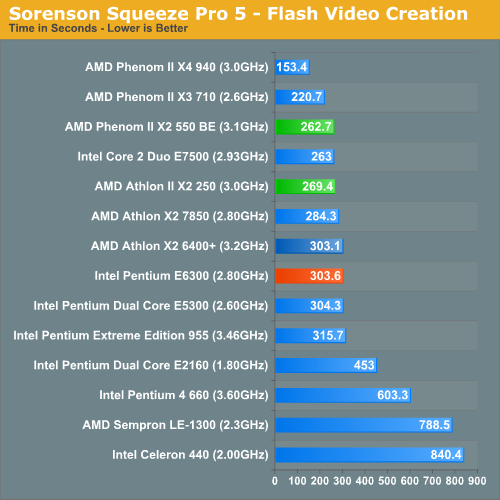
WinRAR - Archive Creation
Our WinRAR test simply takes 300MB of files and compresses them into a single RAR archive using the application's default settings. We're not doing anything exotic here, just looking at the impact of CPU performance on creating an archive:
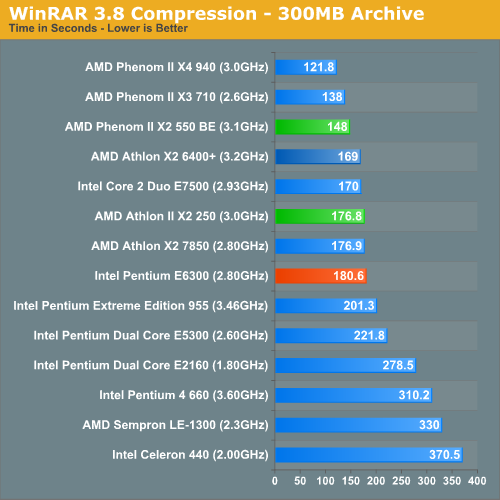
Fallout 3 Game Performance
Bethesda’s latest game uses an updated version of the Gamebryo engine (Oblivion). This benchmark takes place immediately outside Vault 101. The character walks away from the vault through the Springvale ruins. The benchmark is measured manually using FRAPS.
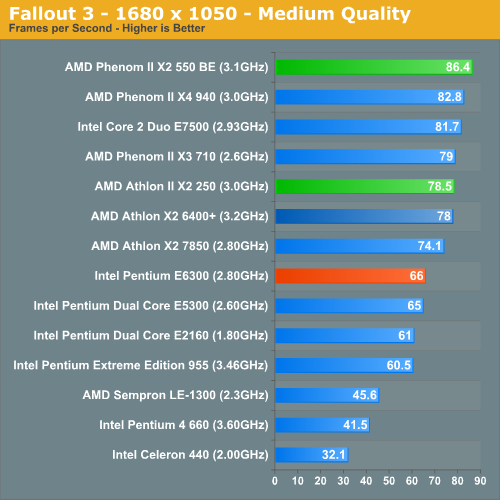
Gaming performance clearly goes to the Athlon II X2 and the Phenom II X2. Because of its high clock speed and very high core-to-cache ratio, the Phenom II X2 550 is actually faster than the Phenom II X4 940 in this test. Note that Fallout 3 isn't particularly heavily threaded so the X4's additional cores don't do much good here.
Left 4 Dead
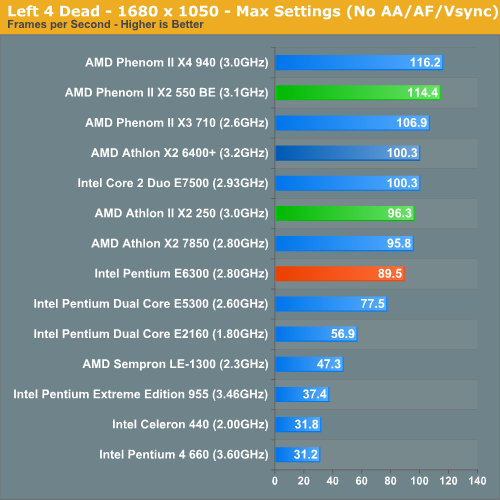
AMD continues to hold on to the gaming performance lead.
FarCry 2 Multithreaded Game Performance
FarCry 2 ships with the most impressive benchmark tool we’ve ever seen in a PC game. Part of this is due to the fact that Ubisoft actually tapped a number of hardware sites (AnandTech included) from around the world to aid in the planning for the benchmark.
For our purposes we ran the CPU benchmark included in the latest patch:

In the newer game engines we see the E6300 catching up to the Athlon II X2 250. The old Pentium 4 660 starves our testbed's GeForce GTX 280 for data; it's horrendously slow.
Crysis Warhead
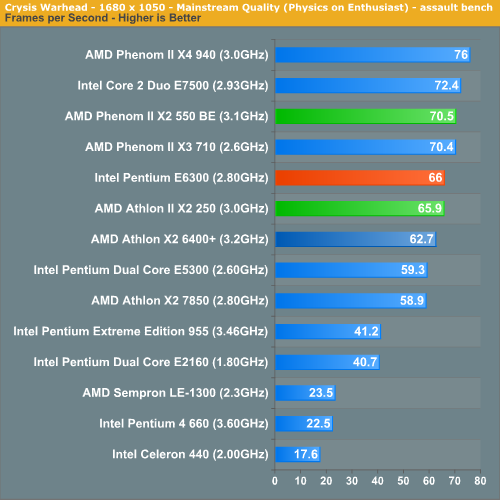
Power Consumption
Both the Athlon II X2 and Phenom II X2 are light on the power consumption. Our Athlon II X2 sample actually drew more power under load, possibly because of its larger L2 caches which operate at full clock speed rather than at the 2.0GHz un-core clock of the Phenom II's 6MB L3. Alternatively, it could just be poor BIOS power management support for the Athlon II at this stage.
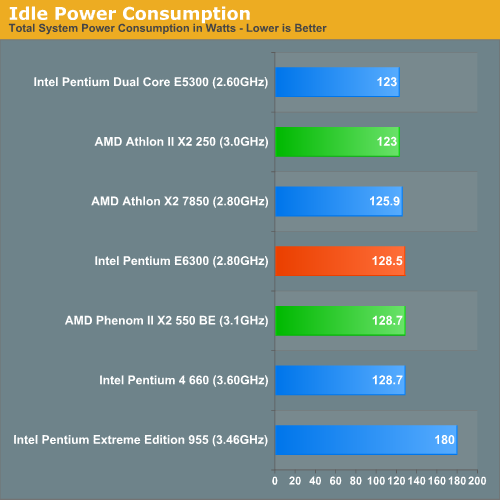
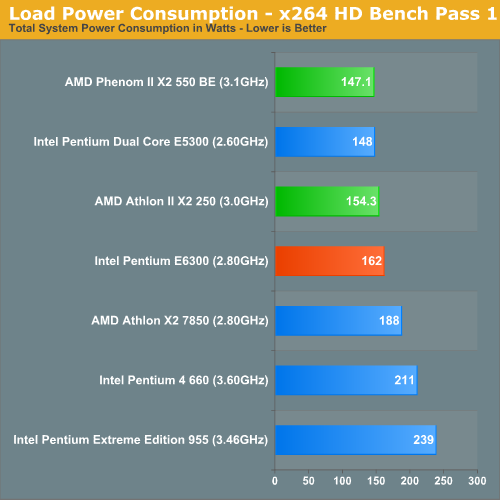
Overclocking
Both the Athlon II X2 and the Phenom II X2 managed to overclock to about the same levels. Without any additional core voltage they were able to run at 3.5 - 3.6GHz, with the Athlon II being able to go a bit higher thanks to being free of any L3 cache. With less than 10% additional core voltage I was able to get both chips up to 3.7GHz. The Athlon II X2 250, when overvolted, managed to reliably hit 3.75GHz.
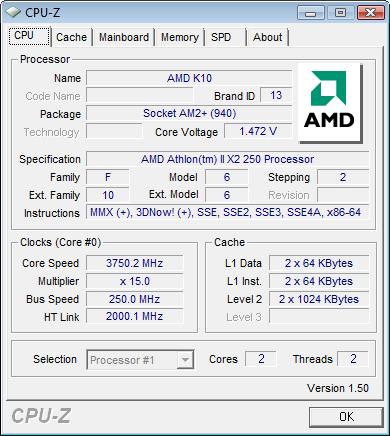
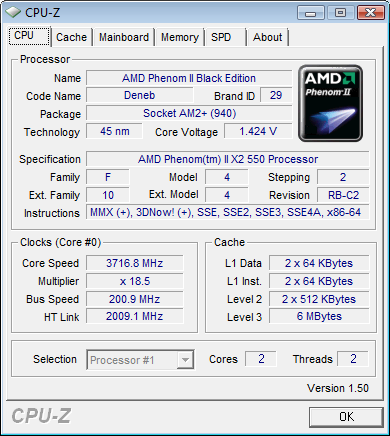
Gary's sample was able to work solid at 4.0GHz while mine would fail at 3.8GHz or above.
| Processor | Highest Overclock (Stock Voltage) | Highest Overclock (Overvolted) | % Increase over stock |
| AMD Phenom II X2 550 BE | 3.5GHz | 3.7GHz | 19% |
| AMD Athlon II X2 250 | 3.6GHz | 3.75GHz | 25% |
| Intel Pentium E6300 | 3.40GHz | 3.57GHz | 28% |
The Pentium E6300 topped out just under 3.6GHz with ~10% additional voltage. I noticed a strange trend when overclocking the E6300. I set the FSB to 340MHz, which when multiplied with the CPU's 10.5x multiplier should yield 3.57GHz. Yet with no additional voltage, the CPU would hardly ever go above a 10.0x multiplier once in Windows - resulting in a 3.40GHz clock speed:
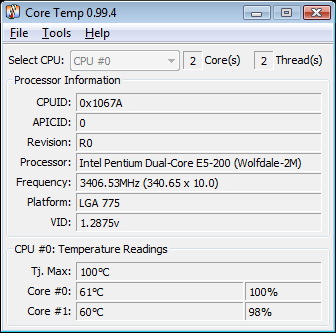
The chip wasn't throttling due to heat, it simply would not run at 3.57GHz without any additional voltage. As soon as I gave it more voltage or as soon as I disabled EIST, the CPU ran at its correct frequency:
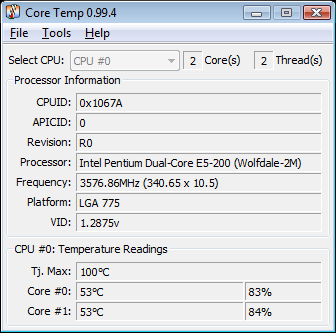
All I did was disable EIST, although increasing the VID also resulted in the same thing
Even with additional voltage however I wasn't able to get the E6300 stable at above 3.57GHz.
| Processor | x264 Pass 2 | Cinebench XCPU | Crysis Warhead |
| AMD Phenom II X2 550 BE @ 3.7GHz | 11.0 fps | 8224 | 74.5 fps |
| AMD Athlon II X2 250 @ 3.75GHz | 11.0 fps | 7968 | 75.0 fps |
| Intel Pentium E6300 @ 3.57GHz | 11.7 fps | 8096 | 80.8 fps |
The Pentium E6300 is actually quite competitive when overclocked and appears to scale very well with additional clock speed. It also helps that AMD's clock speed advantage shrinks once we overclock these chips a bit.
Final Words
With the Athlon II X2 250 and the Phenom II X2 550 AMD has released two very competitive dual-core parts. They both perform and overclock well and are easily competitive with Intel's Pentium E6300.
Choosing between the two can be difficult; the Athlon II's lower price tag is nice but the large L3 cache of the Phenom II X2 550 is responsible for anywhere from a 3 - 20% increase in performance depending on the application.
I've really got no complaints here. AMD has done very well in both the pricing and execution of its first 45nm dual-core products. If anything, the impetus is on Intel to bring its 3MB L2 based Core 2 processors down to the sub-$100 price range. Sell the current Pentium E5xxx line as Celerons and move the Core 2 Duo E7xxx down to Pentium E-class pricing.
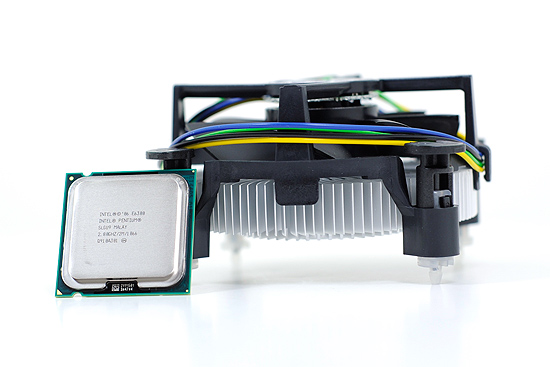
Intel seems intent on keeping the Pentium E parts as crippled as possible, so the scenario above may not happen. But if it does, you can thank AMD for keeping competition alive.
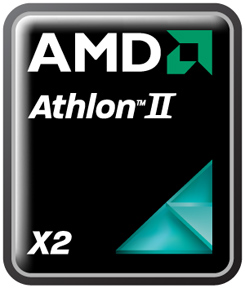

As for AMD. I was disappointed when the first Phenom bid farewell to the Athlon name, but with the introduction of the Athlon II I'm glad to see that AMD is doing the brand justice.



No comments:
Post a Comment